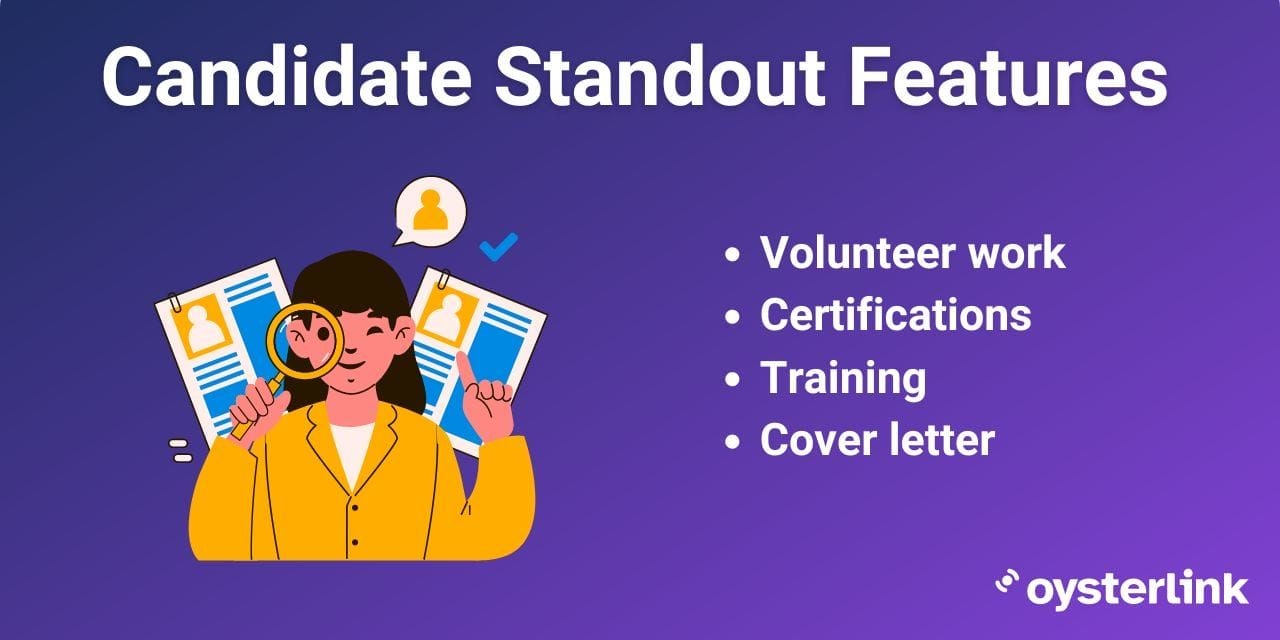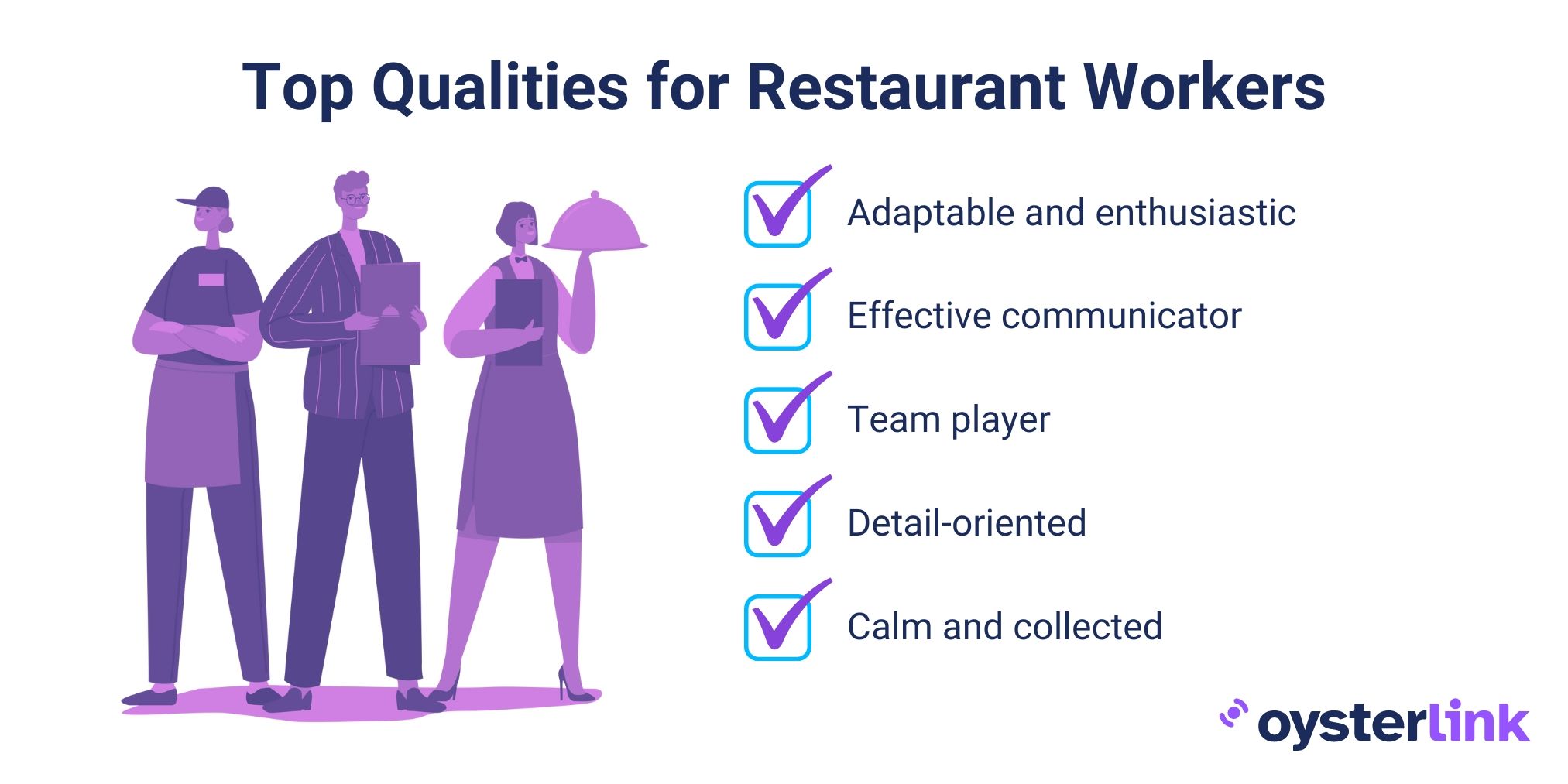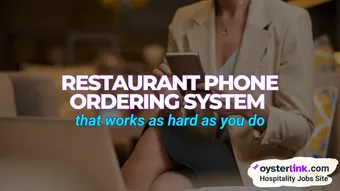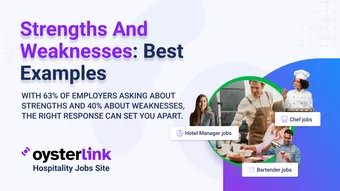Hire Restaurant Staff: 3 Key Takeaways
- 400,000+ job seekers are actively searching on hospitality platforms like OysterLink, giving restaurants instant access to qualified candidates.
- 10 essential steps make up the full hiring process designed to reduce turnover and boost retention.
- 80 resumes per day are reviewed for entry-level roles, highlighting the need for structured evaluation methods.
To hire restaurant staff without wasting time or resources, you need a clear strategy.
As restaurant sales rose 12% in 2023 and continue to grow, the pressure to build high-performing teams is greater than ever.
This guide walks you through every step to help you attract, assess, and retain top talent in a competitive market.
How To Hire Restaurant Staff
According to research by Houlihan Lokey, restaurant sales increased by 12% in 2023 and they're expected to keep growing year on year.
This also means restaurants will need to hire more employees, so knowing the steps to get the people you need as an employer is important.
Let's go through each step individually and discuss what it entails.
1. Identify Roles You'll Need
Knowing how to recruit restaurant staff starts by clearly figuring out the key positions your restaurant requires.
Think of these positions like puzzle pieces that complete the big picture.
For instance, imagine your Head Chef as the kitchen's captain, making sure it operates efficiently and all dishes going out are on point.
The Sous Chef supports the captain, directly supervising kitchen team members.
For kitchen members, also known as back-of-house roles, you might need any number of the following:
- Line Cook
- Prep Cook
- Cook
- Chef
- Head Chef
- Executive Chef
- Pastry Chef
- Kitchen Manager
Depending on the type of establishment and the size, you might not even need a Head Chef or an Executive Chef.
Smaller, family-owned businesses typically have one Chef and several Cooks or Line Cooks to help out with preparing dishes.
You won't know how to hire kitchen staff until you know how many of each role you need.
Only big restaurants or restaurant chains employ Head Chefs and Executive Chefs since they need to manage multiple kitchens and restaurants.

Now, it's time to shift your focus to the dining area.
Here are some of the roles you might need to fill:
- Waiter/Waitress
- Server
- Host/Hostess
- Barback
- Bartender
- Sommelier
- Restaurant Manager
- Assistant Restaurant Manager
- Receptionist
- Hotel Manager
Again, whether you need all of the roles above depends entirely on the size and type of your establishment.
If you're operating a restaurant and not a hotel, you obviously won't need a Hotel Manager or a Receptionist, since you'll have a Host/Hostess greeting the guests.
Similarly, not all restaurants employ both Servers and Waiters.
The differences between these two roles are quite minor and most establishments choose to hire one or the other.
As for how many of each role you'll need to hire, that depends entirely on the size of your establishment.
We have a separate article explaining how to staff a restaurant and how to calculate how many employees in each role you'll need.
2. Craft Simple Job Descriptions
Now that you’ve got a handle on the roles your restaurant needs, it’s time to outline them clearly.
Think of job descriptions as straightforward roadmaps.
Your goal is to provide potential candidates with a crystal-clear understanding of what the job entails.
If you want to know how to hire restaurant staff, you have to start with job descriptions.

When creating job descriptions, skip the jargon and focus on being direct and clear.
Describe each role with authenticity, giving candidates an accurate glimpse of their responsibilities.
Be sure to highlight how each role contributes to the overall vibe of your restaurant.
By the time candidates finish reading it, they should clearly understand the role’s responsibilities, how it contributes to your restaurant’s ambiance and the essential qualities for excelling in the position.
Here at OysterLink, we have free job descriptions for each specific restaurant and hospitality position.
You can use our job descriptions as templates and tweak them so they'll fit your specific needs and requirements.
Make sure to highlight opportunities for growth and development within your restaurant.
Emphasizing career progression can attract candidates seeking long-term employment.
Clearly stating compensation, benefits, and any unique perks your restaurant offers can make your postings more appealing.
Transparency in these areas helps set clear expectations and attracts candidates who align with your restaurant's values.
3. Post Your Job Ad
Now, let’s uncover the right additions to your team.
Start by exploring different paths to connect with potential candidates.
With the internet and the many job platforms available out there, you can gain access to hundreds of potential applicants.
OysterLink, in particular, has made it easier than ever to post a job and tap into a large restaurant and hospitality talent pool.
If you want to find the right candidates in the shortest amount of time possible, you can't beat a job advert on a platform that has over 400,000 hospitality job seekers.
It's the best way to hire restaurant employees.
Another way of finding applicants is by attending events like the National Restaurant Association Show or tapping culinary schools like The Culinary Institute of America.
That being said, this requires significantly more time and effort since it involves traveling and networking.
Consider the timing of your job postings to maximize visibility.
Posting during peak times when job seekers are most active can increase the number of applications you receive.
Additionally, ensure your job ads are mobile-friendly, as many candidates search for jobs on their smartphones.
4. Use Employee Referral Programs
Leveraging your current employees' networks can be an effective strategy for finding qualified candidates.
Encourage your staff to refer individuals they believe would be a good fit for your restaurant.
Implementing an employee referral program with incentives, such as bonuses or additional time off, can motivate your team to participate actively.
Implementing a structured employee referral program also leads to faster hiring times and better cultural fits.
Offer incentives to current employees who refer successful candidates, and regularly communicate the program's benefits to encourage participation.
5. Evaluate Candidate Fit
As you review applications and profiles, focus on gathering insights that can hint at candidate fit and potential.
While you can’t fully gauge who’s a perfect fit from a resume, you can identify certain indicators.
Look for relevant experiences, such as previous work in similar settings or roles, that demonstrate familiarity with the demands of your restaurant environment.
Examine any volunteer work, certifications or training that aligns with your values, such as dedication to culinary excellence or exceptional service.

Additionally, consider any personalized elements in the application, such as a well-crafted cover letter that showcases enthusiasm for your restaurant’s values.
Lastly, look for consistency between the candidate’s stated career goals and the opportunities your restaurant offers.
6. Implement Trial Shifts to Assess Skills
Before making a final hiring decision, consider scheduling trial shifts for shortlisted candidates.
This hands-on approach allows you to observe their skills, work ethic, and how well they integrate with your existing team in a real-world setting.
It's an effective way to assess practical abilities beyond the interview process.
Ensure that trial shifts are structured, with clear objectives and feedback provided to the candidate afterward.
7. Select the Right Candidates
With a clear understanding of the roles, well-crafted job descriptions and insights into candidate fit and potential, it’s time to move to the interview stage.
In this phase, you find the puzzle pieces that perfectly fit your team.
During interviews, keep things conversational and authentic.
Start by asking about their experiences, not just in terms of skills, but also in handling various scenarios that may arise in a restaurant environment.
In addition to evaluating skills and experience, consider the cultural fit of potential hires.
Assess whether their values, attitude and work style align with your restaurant's culture.
Hiring individuals who resonate with your establishment's ethos can lead to better teamwork and employee retention.
During interviews, ask questions that reveal candidates' adaptability, customer service philosophy, and ability to collaborate effectively.
Listen closely to how they communicate and collaborate, as these interpersonal skills are vital.
We have a whole section dedicated to interview questions for almost every position and role in hospitality, so if you need inspiration, feel free to check it out.
Don’t forget to discuss their enthusiasm for your restaurant’s mission and values. A genuine passion for the culinary world and a commitment to outstanding service are attributes that can truly enrich your team.
By meticulously selecting candidates who align with your vision and ethos, you’re shaping a cohesive team that can deliver exceptional experiences to your customers.
8. Streamline Your Hiring Process
Now that you have a clear blueprint for building your restaurant dream team, it’s time to streamline the hiring process itself.
Create a structured hiring timeline that outlines the various stages — from posting job listings to making final selections.
This helps keep the process organized and ensures timely communication with candidates.
Make sure also to use technology to your advantage.
Online application systems, video interviews and digital assessments can simplify the process and make it more accessible for candidates.
During interviews, ask tailored questions that provide insights into candidates’ suitability for the role and their alignment with your restaurant’s values.
Check our Waitress interview questions for inspiration!
Keep the selection process collaborative, involving relevant team members to gather diverse perspectives.
Lastly, ensure transparent and timely communication with candidates at every step, even if they’re not selected.
Providing constructive feedback can leave a positive impression and maintain a good reputation for your restaurant.
9. Use Technology in Hiring
Hiring in hospitality is fast-paced, and outdated methods can slow you down.
Using tech like applicant tracking systems, automated screening tools and online assessments can help you hire faster without sacrificing quality.
Here’s how:
- Applicant Tracking Systems (ATS): Imagine you’re hiring for multiple roles in a busy restaurant.
Instead of manually sifting through dozens of resumes, an ATS automatically sorts applications based on experience and even schedules interviews.
- Automated Screening Tools: Use automated tools to filter applications based on key skills, certifications, and experience.
You can even use it to flag top candidates, saving you hours of manual review.
- Online Assessments: Before scheduling interviews, you can use online assessments to test a candidate’s knowledge or customer service skills.
For example, if you’re hiring a Line Cook, a short quiz on kitchen safety and knife skills can help you identify the most qualified applicants upfront.
These tools don’t just save time—they help you hire smarter, reduce turnover, and build a reliable team quickly.
10. Offer Competitive Compensation and Benefits
To attract and retain top talent, it's crucial to offer competitive wages and benefits.
Research industry standards in your area to ensure your compensation packages are appealing.
Consider offering additional benefits such as health insurance, paid time off, employee discounts, and opportunities for professional development.
A comprehensive benefits package can differentiate your restaurant from competitors and foster employee loyalty.
Advice From an Industry Professional
We recently did an interview with Carolina Franco, a Human Resource Director for Renaissance Hotels.
We asked her how difficult it is for her to find a good candidate, and this was her response:
"Finding a good candidate depends on where the job is posted. Many apply just to explore options, adding to the challenge.
My coordinator and I review around 80 resumes daily, especially for entry-level roles.
For Director of Operations or Hotel Manager roles, we review 30 to 40 resumes a day.
Choosing between experiences and assessing culture fit from resumes is tough, making interviews essential."
Qualities To Look for in New Hires
Just as each flavor contributes to a dish, the qualities you seek in new hires will define the flavor of your establishment.
In the world of restaurants, certain traits define the perfect fit for your restaurant’s culture.
Remember that although skills can be taught, the following underlying qualities serve as the building blocks of a remarkable team.
Adaptability and Enthusiasm
Restaurants are fast-paced arenas. Seek candidates who thrive in change, eagerly taking on challenges like sudden rushes or new menu experiments.
Their enthusiasm infuses your team with a positive energy that keeps customers and fellow staff happy.
Effective Communication
Clear communication is the backbone of seamless service.
Look for individuals who can relay orders accurately, converse with customers and collaborate smoothly with colleagues.
A team that communicates well ensures that everyone’s on the same page.
Team Player Mindset
Like the gears in a well-oiled machine, every team member matters.
Prioritize candidates who value teamwork—i.e., working together for shared success.
A team player’s mindset creates an environment of cooperation, leading to good teamwork and high morale.
Attention to Detail
Whether it’s plating dishes or maintaining the dining area, the little things matter.
Look for new hires who pay attention to details, ensuring quality in presentation and upkeep.
Their dedication shines through in the finer aspects that customers notice.
Calm Under Pressure
Restaurants can be intense. Look for candidates who stay composed during busy times and multitask efficiently.
Those who handle pressure gracefully ensure consistent service even when things get hectic—and things almost always are.

How To Train New Hires
Training new hires is the cornerstone of building a resilient and committed restaurant team.
Also, consider a comprehensive training approach that combines the following key strategies.
Here are some training tips for hiring restaurant employees.
Implement Hands-On Learning and Set Clear Expectations
Before anything else, make sure each staff member understands their job responsibilities and the restaurant’s core values from the outset.
This will help them grasp the importance of their role and how it contributes to the overall team’s accomplishments.
Then, immerse them in hands-on training that mirrors real-world challenges.
Allow them to shadow experienced staff, engage in simulations and actively participate in tasks under guidance.
Offer Mentorship and Continuous Support
Connect each new hire with a seasoned mentor who can provide personalized guidance and answers to questions.
You can also establish regular feedback sessions, both informal and structured, to facilitate continuous improvement.
It’s also best to offer opportunities for skill development through workshops and training sessions, ensuring they remain engaged and enthusiastic.
Allow Clear Communication and Regular Check-Ins
Maintain transparent communication about performance expectations, goals, and progress.
Regular check-ins, for example, can make addressing concerns and making any necessary adjustments easier.
This approach promotes a sense of belonging and encourages open dialogue between new hires and management.
Encourage Autonomy and Reward Effort
Empower new team members to take ownership of their roles and make decisions within their scope.
Recognize and celebrate their achievements, fostering a sense of accomplishment and motivating them to consistently perform at their best.
Find Top Restaurant Talent With OysterLink
The best way to find restaurant and hospitality professionals is with OysterLink.
You can post a job for $50 per listing and get access to over 400,000 different U.S.-based professionals ready to start working.
Some are looking for entry-level jobs while others have years of experience and can join your establishment as Chefs and Restaurant Managers, to name just a few positions.
If you need inspiration, feel free to browse through our job listings to see how other companies are posting their job ads and how they're attracting top hospitality candidates.











Loading comments...